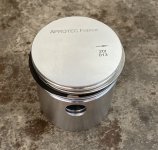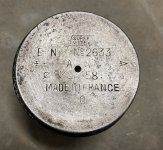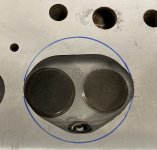Increasing the volume would lower the compression ratio. I don't know what is considered too much for these engines. I found a compression ratio calculator.
 goodcalculators.com
goodcalculators.com
The head gasket measures 1.35mm, so if I assume a thickness of 1mm when tightened, this calculator gives me a value closer to 8.1 to 1. I certainly don't want the ratio less than that.
Compression Ratio (CR) Calculator - Good Calculators
This compression ratio calculator can be used to work out the compression ratio of your engine. The compression ratio is the ratio between two elements: the gas volume in the cylinder with the piston at its highest point (top dead center of the stroke, TDC), and the gas volume with the piston at...
The head gasket measures 1.35mm, so if I assume a thickness of 1mm when tightened, this calculator gives me a value closer to 8.1 to 1. I certainly don't want the ratio less than that.



